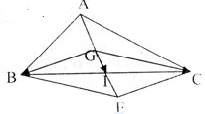Hãy nhập câu hỏi của bạn vào đây, nếu là tài khoản VIP, bạn sẽ được ưu tiên trả lời.

Ta đã biết nếu G' là trọng tâm tam giác ABC thì:
\(\overrightarrow{G'A}+\overrightarrow{G'B}+\overrightarrow{G'C}=\overrightarrow{0}\).
Gỉa sử có điểm G thỏa mãn: \(\overrightarrow{GA}+\overrightarrow{GB}+\overrightarrow{GC}=\overrightarrow{0}\).
Ta sẽ chứng minh \(G\equiv G'\).
Thật vậy:
\(\overrightarrow{GA}+\overrightarrow{GB}+\overrightarrow{GC}=\overrightarrow{0}\)
\(\Leftrightarrow3\overrightarrow{GG'}+\overrightarrow{G'A}+\overrightarrow{G'B}+\overrightarrow{G'C}=\overrightarrow{0}\)
\(\Leftrightarrow3\overrightarrow{GG'}=\overrightarrow{0}\)
\(\Leftrightarrow\overrightarrow{GG'}=\overrightarrow{0}\).
Vậy \(G\equiv G'\).

G A B C M
A. Ta có G là trọng tâm của tam giác ABC
\(\Rightarrow\overrightarrow{AG}=2\overrightarrow{GM}\)
Hay: \(\overrightarrow{GA}=-2\overrightarrow{GM}\)
\(\Rightarrow\overrightarrow{GA}+2\overrightarrow{GM}=\overrightarrow{0}\) ( Đúng)
B. Ta có:
\(\overrightarrow{OA}+\overrightarrow{OB}+\overrightarrow{OC}=\overrightarrow{OG}+\overrightarrow{GA}+\overrightarrow{OG}+\overrightarrow{GB}+\overrightarrow{OG}+\overrightarrow{GC}\)
\(=\left(\overrightarrow{GA}+\overrightarrow{GB}+\overrightarrow{GC}\right)+3\overrightarrow{OG}=\overrightarrow{0}+3\overrightarrow{OG}=\overrightarrow{3OG}\) ( Đúng)
C. \(\overrightarrow{GA}+\overrightarrow{GB}+\overrightarrow{GC}=\overrightarrow{0}\) ( Đúng, đây là điều hiển nhiên)
D. Ta có G là trọng tâm của tam giác ABC
\(\Rightarrow\overrightarrow{AM}=3\overrightarrow{GM}\)
\(\Rightarrow\overrightarrow{AM}=-3\overrightarrow{GM}\)
Vậy đáp án D sai

Theo tính chất trọng tâm ta luôn có:
\(\overrightarrow{GA}+\overrightarrow{GB}+\overrightarrow{GC}=\overrightarrow{0}\)
\(\Leftrightarrow\overrightarrow{GC}=-\overrightarrow{GA}-\overrightarrow{GB}=-\overrightarrow{a}-\overrightarrow{b}\)
\(\Rightarrow m=n=-1\Rightarrow m+n=-2\)

a: \(\overrightarrow{AB}+\overrightarrow{DC}=\overrightarrow{AI}+\overrightarrow{IB}+\overrightarrow{DI}+\overrightarrow{IC}\)
\(=\overrightarrow{AI}+\overrightarrow{DI}=-\left(\overrightarrow{IA}+\overrightarrow{ID}\right)=-2\overrightarrow{IM}=2\overrightarrow{MI}\)
\(\overrightarrow{AB}+\overrightarrow{DC}=\overrightarrow{AC}+\overrightarrow{DB}\)
\(\Leftrightarrow\overrightarrow{AB}-\overrightarrow{AC}=\overrightarrow{DB}-\overrightarrow{DC}\)
\(\Leftrightarrow\overrightarrow{CA}+\overrightarrow{AB}=\overrightarrow{CD}+\overrightarrow{DB}=\overrightarrow{CB}\)(luôn đúng)
=>ĐPCM
b: \(\overrightarrow{GA}+\overrightarrow{GB}+\overrightarrow{GC}+\overrightarrow{GD}\)
\(=2\cdot\overrightarrow{GM}+2\cdot\overrightarrow{GI}=\overrightarrow{0}\)

Mệnh đề C sai
\(\overrightarrow{GA}+\overrightarrow{GB}=-\overrightarrow{GC}\)
Mà hai vecto \(\overrightarrow{GC}\) và \(\overrightarrow{AM}\) ko cùng phương nên đẳng thức \(\overrightarrow{GA}+\overrightarrow{GB}=\frac{3}{2}\overrightarrow{AM}\) ko thể xảy ra

Ta có: \(\overrightarrow{GB}=\overrightarrow{GA}+\overrightarrow{AB}\)
\(\overrightarrow{GC}=\overrightarrow{GA}+\overrightarrow{AC}\)
\(\overrightarrow{GD}=\overrightarrow{GA}+\overrightarrow{AD}\)
Suy ra: \(\overrightarrow{GA}+\overrightarrow{GB}+\overrightarrow{GC}+\overrightarrow{GD}=4\overrightarrow{GA}+\overrightarrow{AB}+\overrightarrow{AC}+\overrightarrow{AD}=0\)

Lời giải:
a) Gọi giao của hai đường chéo là $I$ thì $I$ là trung điểm của $AD$ và $BC$
Do đó, \(A,G,I,D\) thẳng hàng. Áp dụng tính chất của đường trung tuyến:
\(\bullet \overrightarrow{GA}=\frac{-1}{3}\overrightarrow{AD}\)
\(\bullet \overrightarrow{GB}=\overrightarrow{GA}+\overrightarrow{AB}\)
\(\bullet \overrightarrow{GD}=\frac{2}{3}\overrightarrow{AD}\)
\(\Rightarrow \overrightarrow{GA}+\overrightarrow{GB}+\overrightarrow{GD}=2\overrightarrow{GA}+\overrightarrow{AB}+\overrightarrow{GD}=\frac{-2}{3}\overrightarrow{AD}+\overrightarrow{AB}+\frac{2}{3}\overrightarrow{AD}\)
\(\Leftrightarrow \overrightarrow{GA}+\overrightarrow{GB}+\overrightarrow{GD}=\overrightarrow{AB}\)
b) Áp dụng công thức phần a:
\(\overrightarrow{GA}+\overrightarrow{GB}+\overrightarrow{GM}=\overrightarrow{AD}\)
\(\Leftrightarrow \overrightarrow{AB}-\overrightarrow{GD}+\overrightarrow{GM}=\overrightarrow{AD}\)
\(\Leftrightarrow \overrightarrow{GM}-\overrightarrow{GD}=\overrightarrow{AD}-\overrightarrow{AB}\)
\(\Leftrightarrow \overrightarrow{DM}=\overrightarrow{BD}\)
Do đó $M$ là điểm nằm trên đường thằng $BD$ sao cho $D$ là trung điểm của $BM$
* câu a hình như sai rồi đó bn
* câu b mk đọc o hiểu j hết